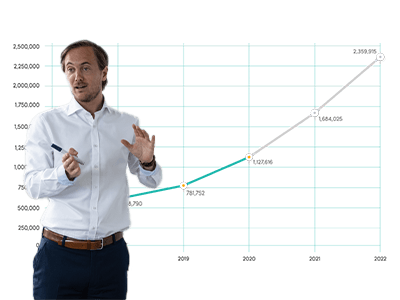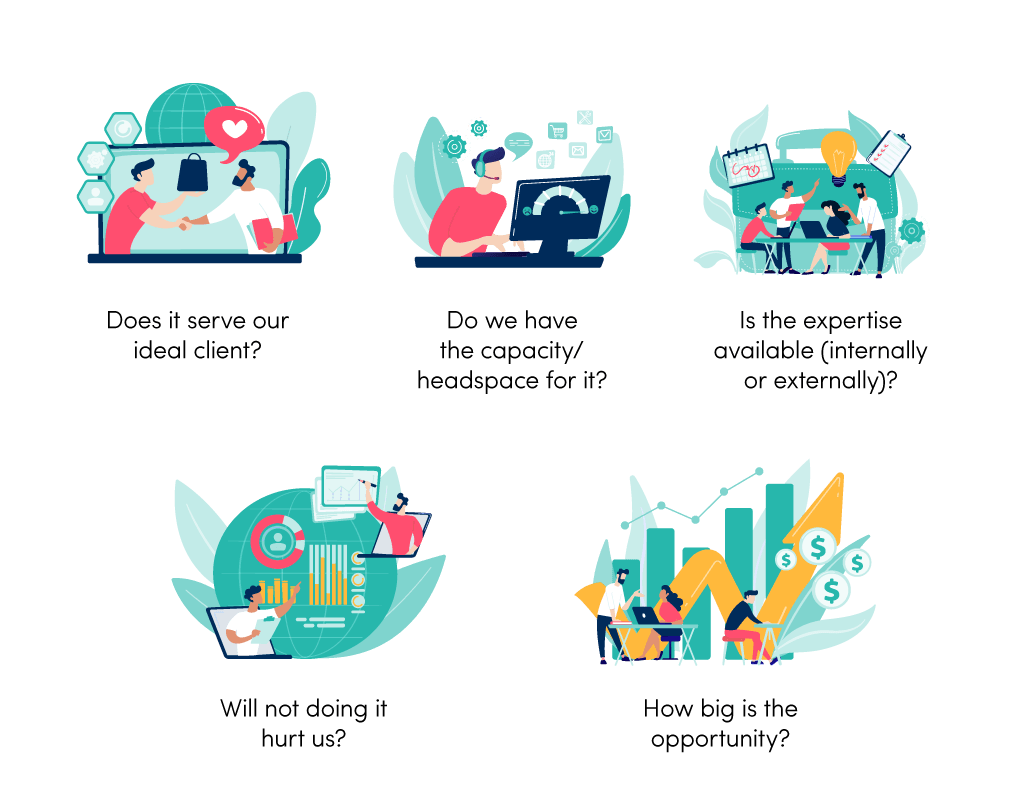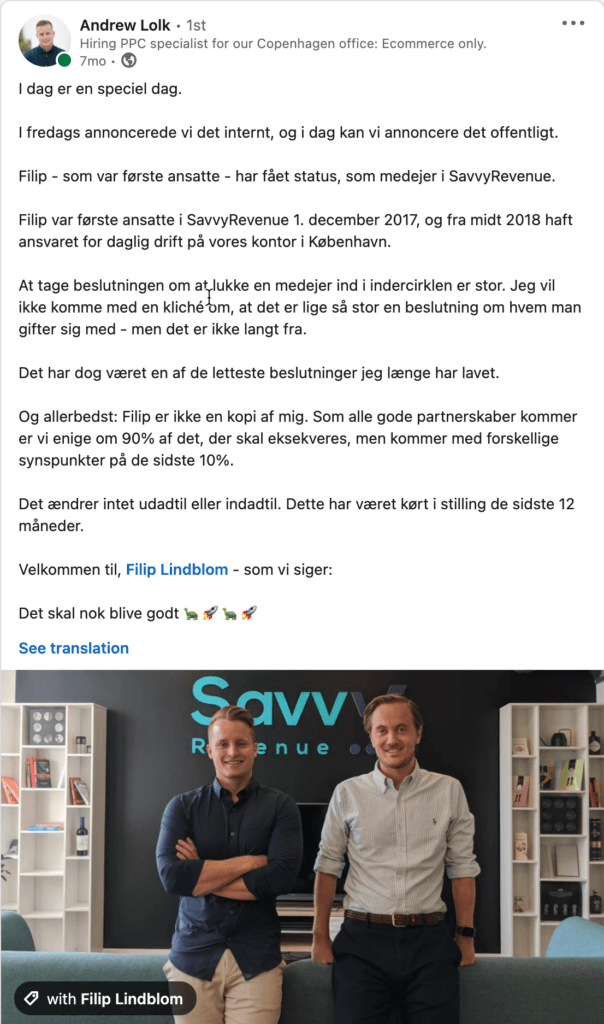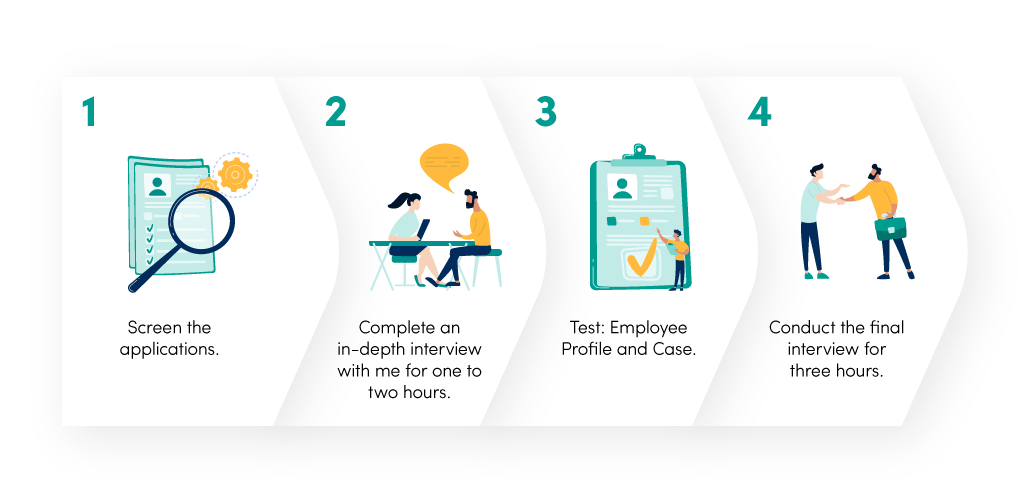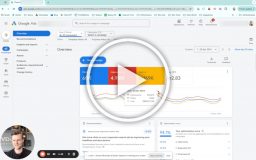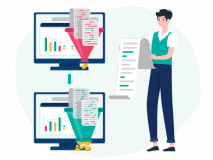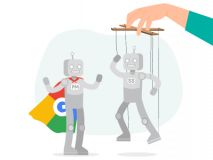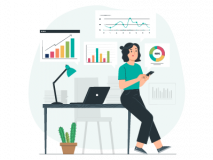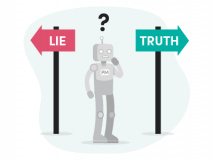Let us move forward with getting the self-glory out of the way.
We exceeded our budget.
We had a budget of $1,000,000, and we exceeded that.
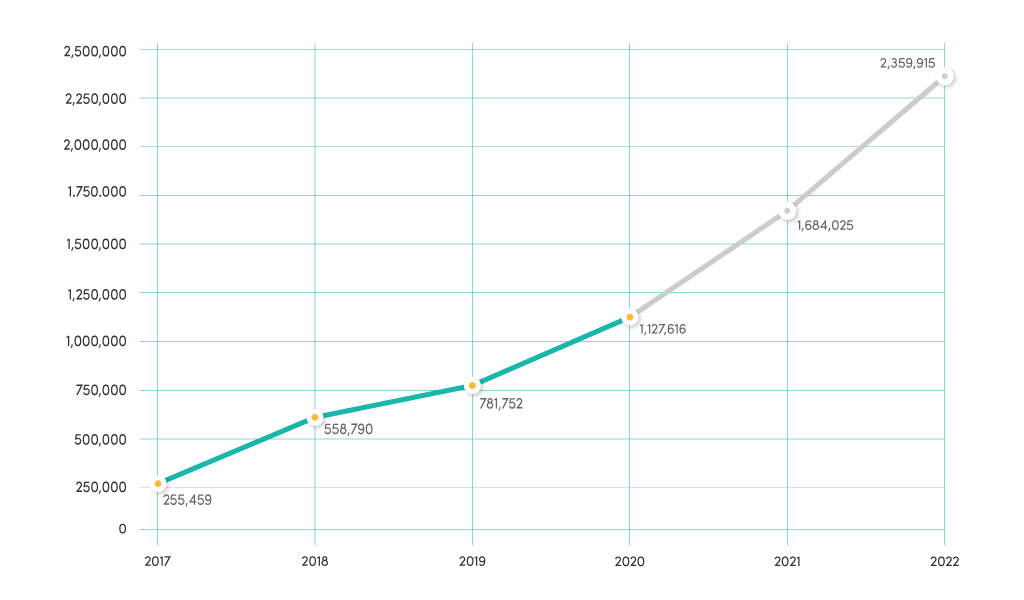
- Target: $1,000,000
- Actual: $1,130,000
We experienced a steady 69% growth from 2019, which exceeded our goal of 50% growth.
We’re now nine people (three new hires in 2020).
We lost one client (one of mine) and amicably said goodbye to another.
Why You Don’t Hear from Me as Often
My partner Filip and I were talking about this the other day. I started sharing these articles quarterly. Then, they became semi-annual updates. Now, they’re annual.
It’s not because I write less.
We just have fewer new things to write about.
A lot of my quick insights also happen in Slack communities for agency owners (primarily GrowthComet by Ross Hudges of SiegeMedia).
With that being said, there are several things that we have improved at SavvyRevenue throughout the year, which you might find interesting.
The Balance Between Being New and Exciting vs. Being Heads Down and Doing the Job
In 2020, we entered the phase of Savvy’s trajectory where we just needed to shut up, put our heads down, and execute.
Most of the new things we implemented in 2020 weren’t really new but were, rather, iterations of previous frameworks. Fine-tuning, tweaking, reiterating.
You can’t just keep throwing new things against the wall. Sometimes, you need to let the current things dry up to make room for the new.
For entrepreneurs, and even employees, who become accustomed to starting new projects, services, clients, offices, etc., this can be hard to get used to. But it’s so important to slow down from time to time.
Our Original Vision
To this day, I still believe that our greatest advantage at SavvyRevenue comes from being able to choose our clients.
It’s so easy to get caught up in the moment trying to help everybody. I genuinely believe that, for most people, it’s about knowing you can’t help everybody that comes knocking.
We lost two clients in 2020. One was from our end, and the other had an in-house team they felt could do a better job.
I believe a big part of this is A) yes, we do great work, but B) we also continually become better at identifying which advertisers fit into our system and which do not.
Granted, COVID-19 was pretty good for many of our clients, but not for all of them. Yes, eCommerce did better, but some industries were hit hard and are still just recovering.
One funny observation: I’ve been asked countless times how we have dealt with the flood of clients we must have received because of the pandemic since we are in the eCommerce space. But, during the initial lockdowns, from March to June, we didn’t get any new clients. (We did close two leads, but nothing new otherwise).
This happened for two reasons.
- We’re not positioned for brand new eCommerce businesses.
- Ecommerce businesses were doing pretty well, so why would they change agencies?
Yes, many people started new eCommerce businesses in 2020, but those are not our typical clients. Our clients are established players, and if you were an established eCommerce company when the lockdowns started, then you likely saw your advertising start performing better.
This meant that many eCommerce businesses were reluctant to change their agencies, and many simply couldn’t.
We actually lost two big potential clients based on this. Their performance in 2019 had reached an all-time low, and we were getting ready to take them on in Q2 of 2020. However, because their performance increased due to COVID-19, their priorities changed from figuring out how to get more orders to figure out how to fulfill those orders.
Shiny New Objects Are Easy to Ignore…
… when you don’t have the opportunities in front of you.
Choosing which opportunities you pursue is one of the hardest decisions to make. Anyone who has sought various business fronts (agency-wise, this could be offering different services, developing software, etc.) knows it doesn’t always work out.
When we weigh our opportunities, we do so in this order:
- Does it serve our ideal client?
- Do we have the capacity/headspace for it?
- Is the expertise available (internally or externally)?
- Will not doing it hurt us?
- How big is the opportunity?
The first and last factors are pretty self-explanatory, so I will skip those.
For us, it’s crucial that we have the headspace for whatever opportunity we’re considering. This means that we need the ability to take significant time out of our calendars—that is, time away from our core competencies—to do anything new. Whether this is taking on a new client, hiring a new employee, opening a new office, or offering a new service.
Then, we consider whether or not pursuing the opportunity will hurt us. From the perspective of taking on new clients, this could mean that the perfect client landed on our doorstep, but we didn’t have the capacity for them.
This is a big part of why many agencies start too many services.
“Oh, what if a client goes to another agency that also offers what we do or offers something we don’t?”
If that’s a concern of yours, you need to know two things.
- It’s valid.
- It’s proof of something much more dangerous.
Being concerned about another “full service” agency taking a client from you because it offers a service you don’t is the wrong thing to look at.
Instead, ask: “Why would another agency even be able to take that client from us in the first place?
If you are specialized in a service, it must mean that you are better than the rest at that service. If not, then there is nothing special about it. It gives you no competitive advantage.
Agency or Just a Group of Freelancers?
I speak with a lot of agency owners, and one of the things that I constantly identify is whether an agency is actually an agency or if it’s just a group of freelancers working together.
Most agencies are just collections of freelancers, IMHO.
My definition of an agency is an organization that has:
- A clear philosophy.
- Frameworks for how to work.
- People executing their work based on those frameworks.
Now let’s look at the opposite. A group of freelancers will:
- Work independently.
- Be very channel-driven. (i.e., They will only talk about SEO, PPC, email, etc.)
- Pitch the channel. (They will say, “We do PPC.” But they will offer no aligned process on how to approach tracking, overall campaign structure, growth, etc.)
I see this cropping up at Savvy all the time—especially when things have been going a bit too fast or when new marketing channels have been added for which we haven’t yet developed a specific framework. Early on, this was YouTube advertising. Then, it was Amazon Ads, where we saw tremendous growth in 2020.
What’s Bad About a Group of Freelancers?
Nothing.
Nothing at all.
It’s just not an agency.
Your great performance is a result of you being able to run around spinning plates. As a new agency, relying on individual brilliance is not scalable.
This is not to say it can’t be done. I see it all the time. It’s just so fragile. Your best employee leaves? You’re screwed.
New employees come in and are left on their own because you “don’t want to micromanage”? They start believing that running an “agency” isn’t really that hard, so they leave to try it themselves.
Slowing Down
For the last six months of 2020, everyone on the team heard me say this at least once when they presented their new client’s onboarding plan:
“Don’t you think that’s a bit slow?”
I would look at our slides for major action items and think they were too slow.
Here’s an example:
In hindsight, I think some of the plans were built with too much emphasis on how much time I thought things needed to take.
We hit the mark in all cases, as emphasized by our not losing any of those clients, but, at the same time, we didn’t have a single client say that they thought we moved too slowly.
Also, in some cases, we were a bit too stressed for our liking. Hitting the deadlines became tough, and, in more than one case, we had to reset the deadlines. (Notice how we changed from using deadline to estimate in the slide above?) We reset deadlines when we noticed that other things (like lockdowns in various parts of the world) would hit, and we’d have to reprioritize.
As an agency, we focus on going slow (compared to others), and one thing that we will try to do in 2021 is to see how we can do this even more.
Slow is fast, and fast is slow.
Capacity Planning is Your Cornerstone
As you grow, one of the aspects of running an agency that should be a permanent fixture in your week/month is capacity planning.
As work-life balance is a crucial benefit of working at SavvyRevenue; we need to make sure that we have the capacity to sell. If we don’t have any available specialists, we either have to break our work-life promise, deprioritize existing clients, or have management take on clients.
None of those options are any good.
In the early days, this is pretty simple, but as you become bigger, capacity planning takes on a whole different look.
At the moment, we’re still managing it by connecting our budget forecast, sales pipeline, and estimates for each person’s capacity to a spreadsheet.
As you can see in the early iteration of 2021’s budget for SavvyRevenue below, it doesn’t have to be super complicated.

We’ve chosen to set each person’s capacity conservatively and then be happily surprised.
With a forecast like this, we can easily see:
- How much each specialist can manage at a given time.
- When to hire the next specialist.
- How much a specialist can handle right at the beginning.
- How to spread new clients, so they can get the attention they need.
For 2021, we have expanded this to include a specific overview for when specialists are open to new clients.
Again, we keep it simple.
Being just nine people means we are able to set specific targets for individuals. Some people can handle a client every month when they’re starting out. Others take longer (if they’re not familiar with the tools we use).
In the future, the solution is to create specialist “profiles,” so you don’t have 30 individuals you need to keep track of in the spreadsheet.
With that being said, capacity planning was perhaps 10% of my job at my old agency (which employed 80 PPC specialists), and we had custom-made software and two dedicated onboarding managers, who took care of it as well.
My First Employee Became a Partner
In 2019, it became clear that my partner, Filip Lindblom, deserved to become a partner.
Many will use the sentence, “I couldn’t do it without him/her.”
I think that puts a spin on getting a partner as if you’re forced to appoint this person to be a partner.
No, I don’t want to do it without him. That’s different.
I looked at the following aspects before deciding to make him a partner.
- Can he grow with current and future roles?
- Is he self-sufficient?
- Do I, and others, enjoy working with him?
- Do we share the same values?
- Does he say “no”?
The first one is the most important to me. The others are obvious, but the first point is probably the most meaningful.
Agency owners often start out as the person doing the work—as the specialist. They hire other specialists to do more work and move over to a sales role.
Then, they move into a management role, and, from there, it’s more about being a classic CEO.
That can often happen in a two- to ten-year period. That’s a VERY steep learning curve if you haven’t done it before.
From just running your own little business to managing a team of ten, 20, 50 people?
Entrepreneurs chase this personal growth as if it were a high. They continually try to find ways to become better, so they grow with the business.
I recently listened to the Tim Ferriss podcast with the COO of Shopify, Harley Finkelstein. Much of Shopify’s founding team is still the same, and the company now numbers 6,000 people. That’s been an immense journey for anyone who started out.
Now, back to why this matters.
Partners cost a fortune to get rid of, and it is a complex process.
When you take on a partner, you want to be 100% sure that he or she can grow with the agency. You need to foresee the future needs of the agency and match your prospective partner’s qualifications with those needs. You’re not making someone a partner for what he or she can accomplish this year. You need to see that he or she can continue such accomplishments five, ten, 20 years from now.
That’s a big ask.
And that’s why becoming a partner in your agency should be a big ask.
Some of the worst excuses for getting a partner I’ve heard so far are:
- They do a job I don’t know anything about.
- I don’t want to do it alone.
- If I hired them, they’d be too expensive.
- I don’t want to make sales.
All of these are horrible reasons.
Our Hiring Process Evolved
We used to have three to five interviews scattered around. Sometimes, we’d sit back with a feeling that we were missing something after two to three interviews, so we’d schedule another interview.
On more than one occasion, we lost a candidate because of this. We excused it, telling ourselves that our indecisiveness meant those candidates weren’t good enough.
But we found that not having a set number of interviews made us too indecisive.
So, we changed our hiring process to only two interviews, lasting five hours total.
The process is as follows:
- Screen the applications.
- Complete an in-depth interview with me for one to two hours.
- Test: Employee Profile and Case.
- Conduct the final interview for three hours.
1) Screen the applications
It goes without saying that you shouldn’t spend time on people who don’t fit your criteria.
Unless people show no Google Ads experience, I tend to give them the benefit of the doubt. However, as we are hiring for roles that require great attention to detail, elaborate resumes are a big plus for me.
2) Complete an in-depth interview with me for one to two hours
We then schedule an in-depth interview with me. It consists of four topics.
- The candidate’s background.
- His/her current position, personality, and approach to marketing.
- SavvyRevenue’s culture, workplace, and frameworks.
- His/her salary wishes.
Notice how there are almost no questions about specific Google Ads topics? As cliché as it sounds, we look to hire people for certain behaviors. As long as they have the basic knowledge of Google Ads that we need, we are much more focused on hiring people with the right values and behaviors than those with a certain skill set.
We ask for candidates’ salary wishes early on to understand how we should grade them. Asking for a higher salary means we will scrutinize you more (because we want to make sure you’re worth the higher salary).
We’re thrilled to pay more if a candidate deserves it.
3) Test: Employee Profile and Case
We run an employee profile on all candidates who make it to the final interview, and, internally, we’re still debating whether it works or not.
We use the People Values profile. It’s not a personality profile, but it scores a list of behaviors and competencies.
We analyze the results based on our current employee profiles to find what areas we need to dig deeper into for the final interview.
We also ask candidates to create a Google Ads case. It should take them about an hour, and it is designed to help us better understand how they would design a Google Ads strategy and to give us a sneak peek of how they would create an account structure.
We’ve used this procedure ever since we started, and we have noticed small things in the way people present the case and in the case itself that reveal a lot about their abilities.
4) Conduct the final interview for three hours
The final interview lasts for three hours and includes me, our department lead, and the team lead.
It’s called the final interview because we need to get all questions out during this interview. It creates urgency for us to ensure we get all the information that we need.
The final interview employs the following agenda.
- Discuss the candidate’s background.
- This is a great way to ease everyone into the interview. The candidate is not instantly put in the line of fire. I can ask clarifying questions I missed during the first interview, and the others can follow up as well.
- Present questions from department and team leads.
- Often, these go much more in-depth about Google Ads, Spreadsheet, and other specific skills that are required for the job.
- Have the candidate present and discuss the case.
- Ask closing questions.
- Discuss topics brought up by the candidate.
We follow this up with either a job offer or a rejection letter within two to three days.
If someone is rejected, we use our network to find that candidate a couple of options. We have spent five hours with the candidate, and I know a lot of places in the agency space, so it’s often easy for me to recommend specific places based on the candidate’s profile.
Team Leads Are Our Bottleneck
I’ve known this from the second we entered 2020. Our next big bottleneck wasn’t Filip or me. It was the team lead position.
As our number of PPC specialists rose from three to six in 2020, we knew that adding more specialists to Filip’s team would only result in lower quality feedback from him because he would be stretched thin.
Your employees are only as good as their immediate manager, so we knew that if we wanted to grow beyond the current team, we needed to add a team lead.
As we write in our internal position summary:
The Lead PPC Specialist’s role is to assist and guide PPC Specialists to hit, and exceed, advertising goals.
The qualities that we require from team leads are:
- No bullshit attitude: Say things as they are when they appear.
- Proactive: Always think one step ahead.
- Analysis: Digging deep into accounts allows you to see things the day-to-day specialists don’t.
- Structure/Planning: One minute spent planning saves 60 minutes in war.
- Empathetic: We don’t hire machines. Everyone is human, and we trust that we hire good, honest people unless proven otherwise. That means extending an olive branch is our default.
- Trusting: We trust staff until they prove to us that we should do otherwise.
- Focus on the positive: Did your specialist fuck up four times in a row but never repeated the same mistake? That’s awesome. It means he or she is learning.
- Exercise productive paranoia traits: You always look around the corner for the wrecking ball that is coming so that we can stay clear of it, but you don’t let it paralyze you. Hence the term productive paranoia.
- Long-Term thinking: You are willing to sacrifice the short term for the long-term greater good. Always.
- Preparation: You never underestimate what a difference 15 minutes of preparation before the day, meeting, call, etc., makes before meeting an employee.
- Always positive: You can be annoyed, tired, frustrated, and even angry. But you can never show it. Stay positive. Everything you do, your team will learn and amplify.
Don’t Throw Them to the Wolves
One observation we made early on was that we didn’t want to split up the team.
Even though our new team lead was also our first senior PPC specialist, meaning he had earned his stripes, we didn’t believe it would be wise for his first real managerial position to be managing his colleagues.
We adhered to the following plan.
- Start with our part-time PPC Specialist.
- Expand with one new hire, who was onboarded more slowly.
- Add new hires to the newly formed team.
That way, we ensured that:
- He wasn’t overburdened by the responsibility of two to three team members and his client portfolio at the same time.
- We didn’t have to reassign all his clients immediately.
- His team members wouldn’t have to get used to a new manager, potentially harming their satisfaction in the meantime.
Again, I’ve hired many team leads throughout the years, and not forcing the process has always been key.
Wrapping Up: 2021 Revenue & Hiring Goals
For 2021, we’ll continue with a 50% growth target and have the following areas that we want to expand in:
- PPC team: We’re hiring 5 PPC specialists throughout the year (check out our Danish career page)
- Amazon Ads team: We’re expanding our dedicated team for Amazon Ads in Q2 (hiring now)
- Ad Copywriter: To help our PPC team focus on what makes them great, we’re expanding our team with a dedicated copywriter
2021 will be an exciting year where we hopefully get a bit more out. 2020 was really exciting, but I don’t think anyone is sad about putting it behind us.
